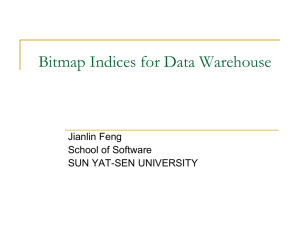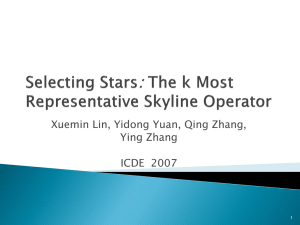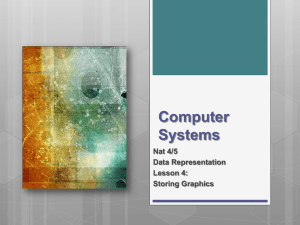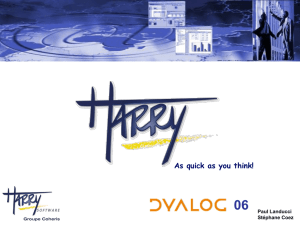wu - Root
advertisement
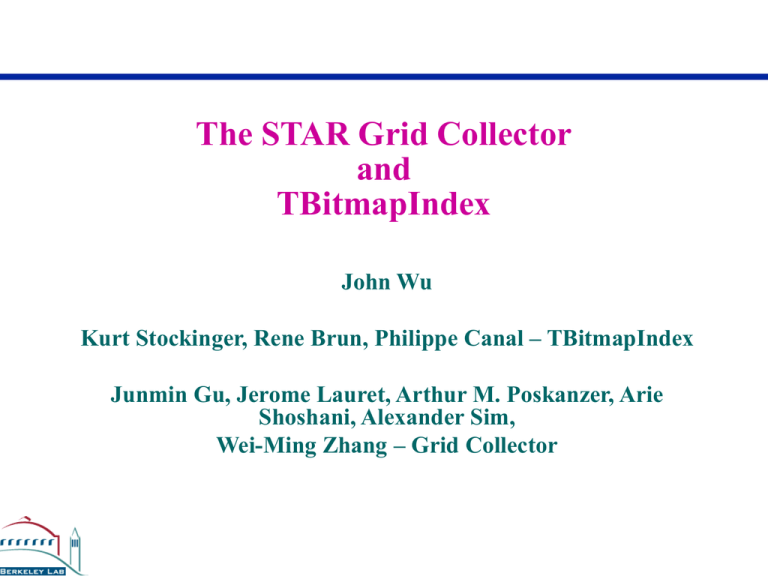
The STAR Grid Collector and TBitmapIndex John Wu Kurt Stockinger, Rene Brun, Philippe Canal – TBitmapIndex Junmin Gu, Jerome Lauret, Arthur M. Poskanzer, Arie Shoshani, Alexander Sim, Wei-Ming Zhang – Grid Collector Outline • TBitmapIndex preview — A preliminary integration of FastBit and ROOT • Grid Collector for STAR — Using FastBit as an efficient event filter • FastBit searching technology — A set of efficient compressed bitmap indices TBitmapIndex: An attempt to introduce FastBit to ROOT Kurt Stockinger1, Kesheng Wu1, Rene Brun2, Philippe Canal3 (1) Berkeley Lab, Berkeley, USA (2) CERN, Geneva, Switzerland (3) Fermi Lab, Batavia, USA Current Status • FastBit: — Bitmap Index software developed at Berkeley Lab — Includes very efficient bitmap compression algorithm • Integrated bitmap indices to support: — TTree::Draw — TTree::Chain • Each Index is currently stored in a binary file Example - Build Index // open ROOT-file TFile f("data/root/data.root"); TTree *tree = (TTree*) f.Get("tree"); TBitmapIndex bitmapIndex; char indexLocation[1024] = “/data/index/"; // build indices for all leaves of a tree bitmapIndex.BuildIndex (tree, indexLocation); // build index for two attributes “a1”, “a2” of a tree bitmapIndex.BuildIndex(tree, "a1", indexLocation); bitmapIndex.BuildIndex(tree, "a2", indexLocation); Example - Tree::Draw with Index // open ROOT-file TFile f("data/root/data.root"); TTree *tree = (TTree*) f.Get("tree"); TBitmapIndex bitmapIndex; bitmapIndex.Draw(tree, "a1:a2", "a1 < 200 && a2 > 700"); Performance Measurements • Compare performance of TTreeFormula with TBitmapIndex::EvaluateQuery • Do not include time for drawing histograms • Run multi-dimensional queries (cuts with multiple predicates) Experiments With BaBar Data • Software/Hardware: — Bitmap Index Software is implemented in C++ — Tests carried out on: • Linux CentOS • 2.8 GHz Intel Pentium 4 with 1 GB RAM • Hardware RAID with SCSI disk • Data: — 7.6 million records with ~100 attributes each — Babar data set: • Bitmap Indices (FastBit): — 10 out of ~100 attributes — 1000 equality-encoded bins — 100 range-encoded bins Size of Compressed Bitmap Indices Total size of all 10 attributes 6.E+08 Size [bytes] 5.E+08 4.E+08 3.E+08 2.E+08 1.E+08 0.E+00 Base data EE-BMI RE-BMI EE-BMI: equality-encoded bitmap index RE-BMI: range-encoded bitmap index Query Performance TTreeFormula vs. Bitmap Indices 1-Dimensional Queries 5-Dimensional Queries 10 100 Time [sec] 1 1 0.1 0.00001 0.0001 0.001 0.01 0.1 0.1 0.00001 1 0.0001 Query box 0.001 0.01 0.1 1 Query box 10-Dimensional Queries TTreeFormula BMI-EE BMI-RE 100 Bitmap indices 10X faster than TTreeFormula Time [sec] Time [sec] 10 10 1 0.00001 0.0001 0.001 0.01 Query box 0.1 1 Network Flow Analysis: Another Example • IDS log shows — Jul 28 17:19:56 AddressScan 221.207.14.164 has scanned 19 hosts (62320/tcp) — Jul 28 19:19:56 AddressScan 221.207.14.88 has scanned 19 hosts (62320/tcp) • Using FastBit/ROOT to explore what else might be going on • Queries prepared by Scott Campbell. More details at http://www.nersc.gov/~scottc/papers/ROOT/rootuse.prod.html See the Scans from the Two Hosts • Query: select ts/(60*60*24)-12843, IPR_C, IPR_D where IPS_A=211 and IPS_B=207 and IPS_C=14 and IPS_D in (88, 164) • Picture: scatter plot (dots) of the three selected variables • Two lines indicating two sets of slow scans Are There More Scans? • Query: select ts/(60*60*24)-12843, IPR_C, IPR_D where IPS_A=211 and IPS_B=207 • More scans from the same subnet Who Is Doing It? • Query: select IPS_C, IPS_D where IPS_A==211 and IPS_B==207 • Picture: the histogram of the IPS_C and IPS_D • Five IP addresses started most of the scans! Grid Collector Put FastBit and SRM together to improve the efficiency of STAR analysis jobs http://www.star.bnl.gov/ Design Goals of Grid Collector Goals Make scientific analysis more productive by • Specifying events of interest using meaningful physical quantities — numberOfPrimaryTracks > 1000 AND SumOfPt > 20 • Reading only events selected • Automating the management of distributed files and disks Practical considerations • Working in the existing analysis framework • Overhead should be insignificant • Efficient for finding a few events (e.g., rare events) as well as a large number of events (e.g., for statistical analysis) Using FastBit to Build STAR Event Catalog • STAR data is organized into several levels • The Event Catalog indexes all tags but only maintains references to other levels Levels of STAR data Event Catalog Tags 1 KB MSS Analysis Object 100 KB Event Summary 1 MB RAW DATA MSS MSS 5 MB Key Steps of Analysis Process 1. Locate the files containing the events of interest – FastBit Event Catalog to associate events with files – File & replica catalogs for locations of files 2. Prepare disk space and transfer – Storage Resource Managers (SRMs): – Prepare disk space for the files – Transfer the files to the disks from HPSS – Recover from HPSS and network transfer failures 3. Read the events of interest from files – Event Iterator with fast forward capability using information from the Event Catalog 4. Remove the files – SRMs perform garbage collection Grid Collector Speeds up Analyses 5 1000 Sample 1 Sample 1 4 Sample 3 100 speedup speedup Sample 2 10 Sample 2 Sample 3 3 2 1 1 0.00001 0 0.0001 0.001 0.01 selectivity 0.1 1 0 0.2 0.4 0.6 selectivity 0.8 more selective less selective • Legend — Selectivity: fraction of events selected for an analysis — Speedup = ratio of time to read events without GC and with GC — Speedup = 1: speed of the existing system (without GC) • Results — When searching for rare events, say, selecting one event out of 1000 (selectivity = 0.001), using GC is 20 to 50 times faster — Even using GC to read 1/2 of events, speedup > 1.5 1 Grid Collector Facilitates Rare-Event Analyses • Searching for anti-3He • Lee Barnby, Birmingham, UK • Previous studies identified collision events that possibly contain anti3He, need further analysis • Searching for strangelet • Aihong Tang, BNL • Previous studies identified events that behave close to strangelets, need further investigation • Without Grid Collector, one has to retrieve many files from mass storage systems and scan them for the wanted events – may take weeks or months, no one wants to actually do it • With Grid Collector, both jobs completed within a day FastBit A compressed bitmap indexing technology for efficient searching of read-only data http://sdm.lbl.gov/fastbit Basic Bitmap Index Data values 0 1 5 3 1 2 0 4 1 b0 b1 b2 b3 b4 b5 1 0 0 0 0 0 1 0 0 0 1 0 0 1 0 0 0 1 0 0 0 0 0 1 0 0 0 0 0 0 1 0 0 0 0 0 0 0 0 0 0 0 0 1 0 0 0 1 0 0 0 0 0 0 =0 =1 =2 =3 =4 =5 A<2 2 <A< 5 • First commercial version — Model 204, P. O’Neil, 1987 • Easy to build: faster than building Btrees • Efficient to query: only bitwise logical operations — A < 2 b0 OR b1 — 2<A<5 b3 OR b4 • Efficient for multi-dimensional queries — Use bitwise operations to combine the partial results • Size: one bit per distinct value per object — Definition: Cardinality == number of distinct values — Compact for low cardinality attributes only, say, < 100 — Need to control size for high cardinality attributes The Special Compression Method in FastBit Is Compute-Efficient Example: 2015 bits 10000000000000000000011100000000000000000000000000000……………….00000000000000000000000000000001111111111111111111111111 Main Idea: Use run-length-encoding, but.. group bits into 31-bit groups 31 bits 31 bits … 31 bits Merge neighboring groups with identical bits 31 bits Count=63 (31 bits) 31 bits Encode each group using one word • Name: Word-Aligned Hybrid (WAH) code • Key features: WAH is compute-efficient because it Uses the run-length encoding (simple) Allows operations directly on compressed bitmaps Never breaks any words into smaller pieces during operations Performance on Multi-Attribute Range Queries 2-attribute queries 5-attribute queries • WAH compressed indexes are 10X faster than DBMS, 5X faster than our own version of BBC • Based on 12 most queried attributes from STAR, average attribute cardinality 222,000 Summary / Future Work • We integrated bitmap indices into ROOT to support: — TTree::Draw — TChain::Draw • Using bitmap index speeds data selection by up to 10X — With approximate answers of 0.1-1% error the performance improvement is up to a factor of 30 • Bitmap indices are also used successfully in STAR as a form of Event Index to speed event access • Future work: — Tighter integration with ROOT to provide more functionality — Store bitmap indices in ROOT files — Integrate with PROOF to support parallel evaluation
